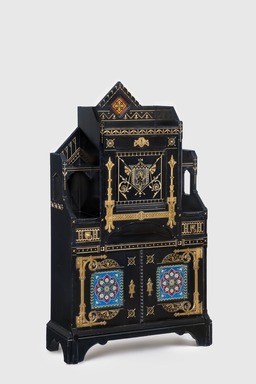Browse

| Accession # | 1991.126 |
|---|---|
| Designer and Manufacturer | Kimbel and Cabus |
| Title | Cabinet-Secretary |
| Date | ca. 1875 |
| Medium | Painted cherry, copper, brass, gilding, leather, earthenware |
| Dimensions | 60 × 35 × 14 in. (152.4 × 88.9 × 35.6 cm) |
| Marks | reverse of each ceramic tile, molded lettering: "MONTREAU / L. M&.Cie / CREIL" |
| Inscriptions | no inscriptions |
| Signed | no signature |
| Credit Line | Bequest of DeLancey Thorn Grant in memory of her mother, Louise Floyd-Jones Thorn, by exchange |
| Location | American Identities: Colony to Nation / Inventing American Landscape |
| Description | Cabinet or secretary; ebonized wood, brass, leather, ceramic tile. Cabinet of plank construction; rectangular block front bottom topped by square fall-front section, which intersects a peaked, pyramidal back support. Deep, narrow side shelves with pierced outer sides over small square side drawers (g, h) flank the central fall-front section. Cabinet (a) rises on blocked feet with curved side support and scalloped base. Bottom front has two doors inset with elaborate, incised, gilt metal, functional hinge plates and escutcheons; all fittings held in place by round-head screws. Center of lower doors inset with ceramic tiles capped at top and bottom with gilt, incised fan motifs. Tile decoration: red, pierced quatrefoil design with white-pedaled, green-stemmed flowers radiating from center rosette, all on a blue ground; side border design of opposing green and black chevrons and green semi-circles on top and bottom, with diamond-shaped motifs in corners. Right edge of proper left door panel contains vertical band of carved, pyramidal decoration. Interior lower cabinet has one adjustable shelf (b) with four holding pegs (c, d, e, f). Lower section of cabinet separated from upper section by a narrow, horizontal, gilt-incised band of alternating vertical slash-and-dot pattern. Upper section of cabinet has fall-front panel with arched and scalloped bottom edge and large gilt, incised, decorative hinge plate and escutcheon. Center panel decorated with winged dragon on a stippled ground in square canopy surrounded by conventionalized gilt-incised floral design. Upper section of cabinet topped by blind gallery, accented by small diamond-shaped marquetry panel. Marquetry decoration: outlined center rosette with four larger solid black radiating triangular petals, all on a yellow diamond-shaped ground with a dark red border outlined in black with solid black diamond-shaped motifs in each corner. Triangular back support of cabinet extends from midway up the fall-front to a peak directly above the marquetry panel. Interior fall-front contains green stippled leather writing surface with gilt on red Greek-key border; single interior drawer (i) and open storage area topped by four deep, narrow storage spaces separated by three dividers. Cabinet retains one original key for lower cabinet doors (j) and later smaller key for upper fall-front door (k). (Sub letters are for description references only) CONDITION - Overall very good. Ebonized finish appears to be intact; gilding along edges of metalwork shows minor wear, ceramic tiles in excellent condition. |
Curatorial Remarks: About this Brooklyn Icon
The Brooklyn Museum is commemorating its 200th anniversary by spotlighting 200 standout objects in its encyclopedic collection.
In 1863 immigrant designers Antonin Kimbel (German) and Joseph Cabus (French) founded their New York–based furniture and decorating firm, Kimbel and Cabus, to outfit the homes of the city’s wealthy middle class. Working in the Modern Gothic style, they combined features of medieval architecture and design with rich surface decoration and bold, clean lines.
This secretary-cabinet is Kimbel and Cabus’s most developed Modern Gothic work and one of the rare examples of this style in the Brooklyn Museum collection. While functional, it was also intended for ostentatious display. Its rectilinear shape and gothic elements create a powerful presence that belies the desk’s relatively small dimensions. The two-legged winged dragon with a shield, or wyvern, is a symbol of valor and protection. Along with medieval references, Kimbel and Cabus broadly appropriated the forms of Asian arts and crafts: here, they used ebonizing, a process of blackening the surface of wood, to imitate Asian lacquer. Finally, they incorporated colorful ceramic French tiles of Islamic inspiration on the bottom doors.
***
Gallery Label
In 1863 immigrant designers Antonin Kimbel (German) and Joseph Cabus (French) founded their New York–based furniture and decorating firm, Kimbel and Cabus, to outfit the homes of the city’s wealthy middle class. Working in the Modern Gothic style, they incorporated features of medieval architecture and design, such as the peaked gable, pointed-arched shelves, oversized hinges, and abstract linear patterns seen on this cabinet. The designers were noted for their innovation, combining historical elements with bold, clean lines, and rich surface decoration. They also broadly appropriated advances and techniques in Asian arts and crafts forms. Here, they used ebonizing, a process of blackening the surface of wood to imitate Asian lacquer.